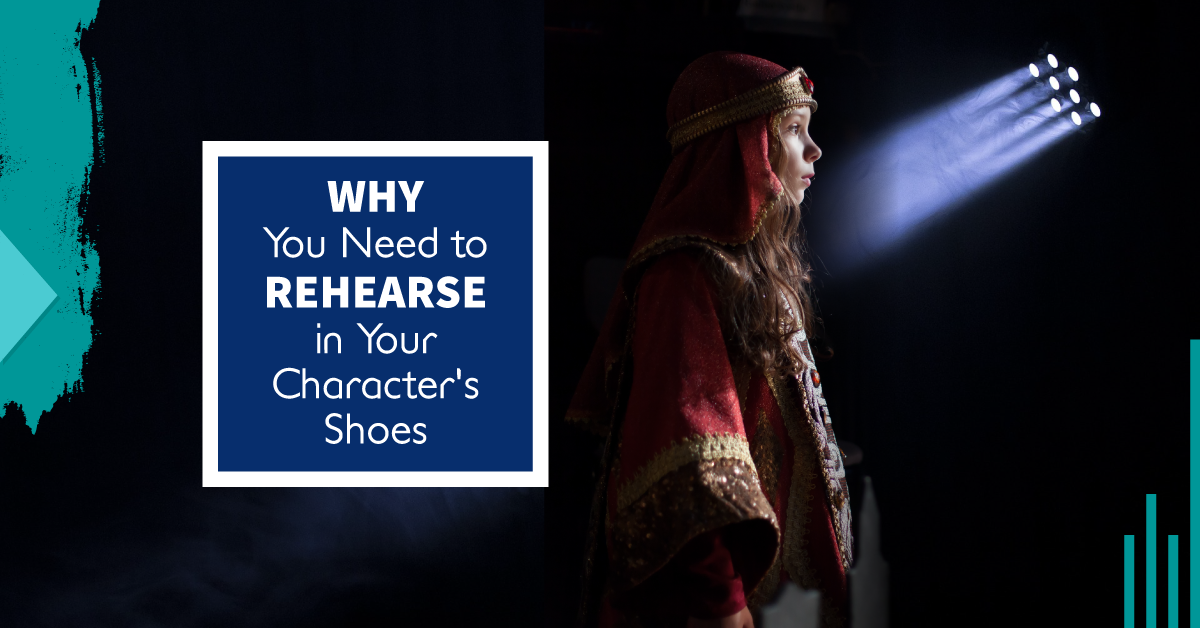Do you have girls who are tired of the same old stereotypes and love something dark and twisted? Camel Dung and Cloves offers rich, eccentric roles with nonstop plot twists that will keep them hooked!
Why You Need to Rehearse in Your Character’s Shoes
There are so many approaches to developing a character and making them fascinating and engaging. Some methods are more analytical, some are emotional, and some are physical. In this case, think of the old saying, “You can’t understand someone until you’ve walked a mile in their shoes.” Rehearsing in your character’s shoes is a very helpful way for students to further develop their characters and increase their own confidence onstage. It seems simple but it’s easy to overlook – directors frequently tell actors to dress comfortably for rehearsal, and actors don’t often start immediately rehearsing in their costumes. But if students are able to start working with their shoes right away, it can make a huge difference.
Your shoes affect your physical movements.
Think of all the different types of shoes out there – boots, flats, sneakers, high heels, flip-flops, sandals, slippers… the list goes on and on. Simply put, the body moves differently while wearing different footwear. You might be able to leap nimbly across the stage in jazz shoes or ballet slippers, but can you do the same movements in steel-toed combat boots? Can you swordfight wearing Converse high-tops? Can you run away in five-inch stilettos?
In rehearsal, as soon as possible, start wearing the shoes you will be wearing onstage. Your need to be confident in your movements while performing, no matter what the role calls for. The sooner you start wearing your show shoes in rehearsal, the more comfortable and poised you will be while performing. It will be one less thing you have to worry about.
This also is useful to do if a character doesn’t wear shoes at all! When I directed Tarzan, the gorilla characters didn’t wear shoes, while the students playing humans did. It was important for the barefooted students to get comfortable being barefoot all the time (some people are weird about their feet!), and the students wearing shoes had to be aware how they moved in their shoes, while also being extra careful not to step on the toes of the students who were barefoot!
If you don’t know right away what shoes your character is wearing, try experimenting with different types of shoes during rehearsal. Look through the script and make notes about what your character might wear, and try out different shoes. Alternatively, make notes of the actions taken during the show, such as climb stairs, dance, fight, run, or tumble. What shoes would be best for your needs as an actor? For example, if you have to jump down off a ledge, you will need shoes with good ankle support. If you need to do turns, shoes with rubber soles might be too grippy to execute the moves properly. This information can help the costume team determine what shoes would work best for you. Once you receive your shoes, try out all your movements right away so you can communicate with the director and costume team if there are any concerns.
Your shoes are part of your costume, which helps to define your character.
Once you know what kind of shoes your character wears, think about how your character feels about their shoes. It seems trivial, but it’s another way of delving deeper into your character and getting to know them better. Why did they choose those shoes? For style, for comfort, for practicality? Did they even have a choice of what shoes to wear? Do their shoes fit them properly? Are the shoes well-maintained or shabby? Does your character change shoes throughout the show? Why?
For example, think about a show like My Fair Lady. Eliza starts as a humble flower seller wearing thick boots, and is made over into a society lady in fancy high heels. How would that affect both the actress playing the role, and the character herself? How does she walk in her everyday boots versus her new, stiff, heeled shoes? At what point does she become more comfortable in her new shoes? How can you, as an actor, accurately show this evolution of movement?
That’s a lot of thought for a simple pair of footwork, isn’t it? But getting those shoes on your feet will really help you with your character, both physically and mentally. And after walking, dancing, and moving in your character’s shoes throughout the rehearsal process, it will be easy to make a smooth transition to walking a mile in their shoes onstage.
Related Articles
The Drama Classroom Companion
by Lindsay Price & Kerry Hishon
The Drama Classroom Companion is filled with articles and exercises to build the skills needed for theatrical performance as well as real world skills like creative thinking, critical thinking, collaboration, and communication.
The Rehearsal Companion
by Kerry Hishon
You’ve chosen the play, paid the royalties, done the script analysis, held your auditions, and cast the show. Tomorrow is the first rehearsal. Are you ready? Really ready? The Rehearsal Companion can help!





